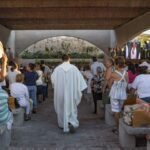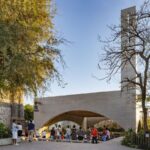Reviving Heritage: Santuario del Señor de Tula

In the aftermath of the devastating earthquake that struck Jojutla, Morelos, Mexico, on September 19, 2017, our team embarked on a mission to reconstruct the Santuario del Señor de Tula. This historic sanctuary, with over five centuries of legacy, stood among the many structures ravaged by the catastrophe, leaving behind a trail of destruction that encompassed homes, schools, and public infrastructure.
A Vision for Restoration and Renewal
The Santuario del Señor de Tula reconstruction project was an endeavor rooted in preserving heritage while embracing modernity. Developed by AGENdA Agencia de Arquitectura + and Dellekamp Schleich, the design sought to honor the sanctuary’s rich history while addressing contemporary needs and environmental considerations.

Innovative Design for Sustainability
Central to the project was the creation of a spacious roof composed of brick vaults, supported by a cast-in-place concrete structure. This innovative design not only paid homage to traditional architectural techniques but also prioritized sustainability. By incorporating structural arches on each side, supported only at the corners, the design facilitated natural ventilation and ample natural light, minimizing the reliance on mechanical cooling systems and artificial lighting.
Reimagining Tradition: A Fusion of Classic and Contemporary
While the floor plan adhered to the traditional cross-shaped basilica typology, the design introduced innovative elements to redefine the sacred space. The gradual elevation from the atrium to the altar fostered a sense of transition and introspection, allowing worshippers to disconnect from the outside world while remaining immersed in the lush tropical surroundings. Blurring the boundaries between interior and exterior, the sanctuary embraced the concept of an open chapel, offering a versatile space for communal gatherings and spiritual contemplation.

Embracing Inclusivity and Multiplicity
By creating a threshold space characterized by fluid boundaries, the Santuario del Señor de Tula welcomed people of all walks of life. This inclusive design ethos aimed to foster a sense of belonging and community, ensuring that the restored sanctuary served as a space for everyone, regardless of background or beliefs.
Through a harmonious blend of heritage preservation, sustainable design, and inclusivity, the Santuario del Señor de Tula stands as a symbol of resilience and renewal, reaffirming its significance as a sacred place of worship and communal gathering for generations to come.




























